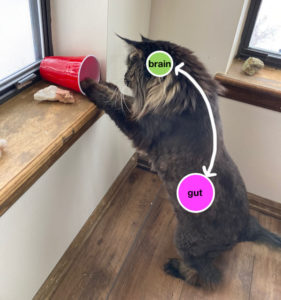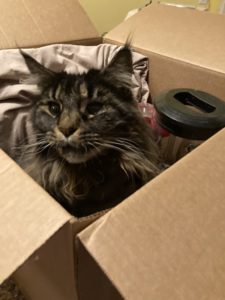
Feeling “gutsy”? “Butterflies” in your stomach? These are the signs that your brain and your gut are communicating with each other. There is constant “crosstalk” between these two organs.
The tiny microbes that call the gut their home form a community or “microbiome”. Some of the ways this microbiome communicates with the brain are:
- Millions of neurons line the GI tract and signal the brain of changes in the microbiome.
- If the brain triggers the release of fight or flight hormones, the movement of the intestines and the content in them changes.
- The GI microbiome affects the development of neural systems that control stress.
- Gut microbes can affect immune cells in the GI tract. These changes are picked up the neurons in the walls of the GI tract.
- Gut microbes produce short chain fatty acids and neurotransmitters that directly affect the brain.
Our cats are also mammals with a similar gut-brain communication. Imbalances in your cat’s GI microbiome can result not only in diarrhea but also can affect mood, anxiety, and conditions such as dermatitis and inflammatory bowel disease (IBD).
How and what we FEED our cats affects the microbiomes in their guts. As we learn more about how the gut talks to the brain, we are finding specific ways to influence these microbiomes through diet. This gives cat owners a low-stress way of managing their cats’ health by feeding them.
probiotics for cats
A microbe is microorganism, usually a bacterium, that causes disease or fermentation. We can influence the GI microbiome through prebiotics, probiotics and synbiotics.
- Prebiotics refer to indigestible fiber that feeds the “good” (beneficial) bacteria in the GI tract.
- Probiotics are live bacteria or yeast that are beneficial to the health of the host – human, cat, dog… – who consumes them.
- Synbiotics refer to the combination of pre- and probiotics – fiber and bacteria/yeast.
The bacteria/yeast can be freeze-dried and packaged as a supplement. The bacteria remain in a “dormant” state until they are exposed to the right conditions of acidity, temperature and water and become active and “live” once more.
DIETARY SUPPLEMENTS FOR YOUR CAT’S GI MICROBIOME
Some of the more common probiotics for cats include Fortiflora and Proviable.
Fortiflora is manufactured by Nestlé-Purina. The supplement contains the bacterium E. faecium SF68 and has been shown to reduce viral and antibiotic-induced diarrhea in cats. A newer version of this supplement, Fortiflora SA, includes the prebiotic psyllium, resulting in an improved resolution of diarrhea. Fortiflora has also been studied with regard to reducing side effects from feline herpes virus. Fortiflora is available over the counter; Fortiflora SA is available through your veterinarian.
Nutramax Proviable is another powdered synbiotic for cats found to be effective in resolving feline diarrhea . Proviable contains seven strains of bacteria: E faecium,
Streptococcus (Enterococcus) thermophilus, Lactobacillus acidophilus, L bulgaricus, L casei, Bifidobacterium bifidum, and L plantarum. Proviable is available over the counter.
Another probiotic on the market features the bacterium Bifidobacterium longum, that has been shown to help cats and dogs stay calm. Calming Care is a Purina product available over the counter.
a diet to maintain your cat’s gi biome
Hill’s Pet Nutrition has developed a canned and dry diet for cats designed to maintain a healthy gastrointestinal microbiome. The food incorporates a blend of prebiotics designed to encourage the growth of “good” bacteria in your cat’s intestines.
Research on cats at the Hills Pet Nutrition Center showed that feeding the “biome” diet increased the “good” bacteria and post-biotics – those short chain fatty acids (SCFA) from fiber fermentation. SCFA are thought to regulate processes in the Central Nervous System and ultimately shape behavior and cognitive function.
MORE ABOUT probiotics for cats
A company called Animal Biome offers to tailor the use of probiotics to the individual cat or dog. The company cites problems with the “one size fits all” approach using probiotics to manage the microbiomes. The composition of the your pet’s microbiome is identified using DNA sequencing. Supplement therapies are available to restore your cat’s microbiome balance.
Other companies offering similar services include Nom Nom and MIDOG.
Probiotics provide us with additional ways to manage not only GI upset but possibly anxiety, skin issues and IBD in our cats. More research should identify additional probiotics for cats that target specific conditions.
SHOULD I USE PROBIOTICS/SYNBIOTICS FOR MY CAT?
For an occasional bout of diarrhea, a probiotic such as Proviable or Fortiflora can be effective. If the diarrhea persists or recurs, see your vet.
Prebiotics, probiotics, and synbiotics are dietary supplements and, as such, are not regulated by the Food and Drug Administration (FDA). Many dietary supplements claim to treat medical conditions and are basically unapproved drugs.
a word to the wise…
Stick with the supplements that have some clinical studies supporting their use. The supplements mentioned in this post are used in many veterinary clinics, have substantial amount of research supporting their development, and are safe to use with your cat.
postscript…
I am moving into a new home and I am concerned about how the process of moving will affect The Feline Purrspective team. As things are getting boxed up, some of my cats were more clingy; my ex-feral cat seemed edgy and paced more. I decided to give the Calming Care supplement a try. So far, the kitties do seem calmer after about a week on the supplement, although, maybe they are just getting used to the moving boxes!
Want to keep up with the world of cats? Subscribe to The Feline Purrspective!

